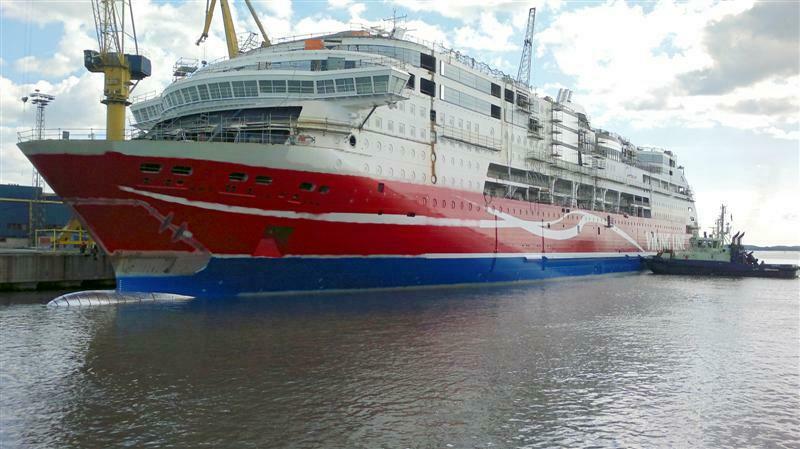 The Viking Grace was launched at STX’s Turku shipyard in August. Sailing for Finland-based Viking Line, the new ship will replace the Isabella on the Turku – Aaland Islands and Stockholm route in January (2013).
The Viking Grace was launched at STX’s Turku shipyard in August. Sailing for Finland-based Viking Line, the new ship will replace the Isabella on the Turku – Aaland Islands and Stockholm route in January (2013).
Built at a cost of 240 million euro, the Viking Grace will be the first large passenger vessel fueled by LNG, according to the company, although her gas-electric powerplant consists of dual-fuel Wartsila engines, allowing her to run on traditional heavy fuel, diesel or LNG.
Fjord Line of Norway will introduce what it calls the first LNG-only fueled large passenger vessel next year when the Stavangerfjord enters service between Norway and Denmark in May. The cruise ferry will feature a powerplant with four Rolls-Royce gas engines. A second vessel, the Bergensfjord, follows in 2014.
At Viking Line, Senior Vice President of Marine Operations Tony Ohman told Cruise Industry News that the ship will run on LNG and use marine gas oil (diesel) as pilot fuel, estimated to be only 1.5 percent of the total fuel consumption. Ohman said that bunkering will take place six times a week in Stockholm via a small supply vessel. There are two tanks onboard holding 200 cubic meters of LNG each, according to Project Manager Kari Granberg.
The consumption of LNG is estimated at 22,500 tons per year, or about 60 tons per day and will be supplied from AGA’s LNG terminal in Nynashamn.
The ship also has tanks for marine diesel as a back-up fuel, and Grandberg said that changing from gas to MGO can be done during normal operations.
Fjord Line’s CEO Ingvald Fardal told Cruise Industry News that the original plan was to run dual fuel, and the company bought eight MAN diesel engines that it still owns. Meanwhile, with support from the Norwegian NOx Fund, Fjord Line decided to go straight to LNG. As the plan was to eventually convert to full-time use of LNG, the vessels were already designed with LNG tank space. The total cost for the two vessels is NOK 1.7 billion.
The Viking Grace is 57,000 tons and 214 meters in length. She will have a top speed of 22 knots, carrying up to 2,800 passengers, and has lane space of 1,275 meters for cargo and 1,000 meters for cars (on two decks). The powerplant consists of four Wartsila 8L50DF engines, with transverse bow and stern tunnel thrusters, and two stainless steel fixed pitch propellers.
The Fjord Line vessels are 25,000 tons and 170 meters long, a critical length for its service, where three waves typically cover 165 meters, according to Fardal. Thus, he said, “170 meters will ensure a more comfortable voyage for passengers.” The vessels are 27.5 meters wide and have drafts of 6.35 meters.
The powerplant consists of four (Rolls-Royce) Bergen BV12PG engines rated at 35.6 MW each for an operating speed of 21.5 knots. The Promas propulsion system has two shaft lines with controllable pitch propellers, rudders and steering gear, as well as tunnel thrusters. Two 296 cubic-meter LNG tanks are equipped with an Acon-gas control system. The cruise ferries will have 206 cabins each, but a passenger capacity of 1,500, plus space for 600 cars and 3,900 tons of cargo.
Excerpt from Cruise Industry News Quarterly Magazine: Fall 2012




